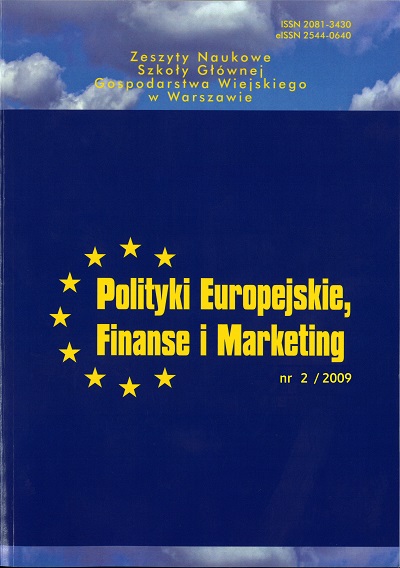Main Article Content
Article Details
Agricultural Insurance Schemes, European Commission, Directorate General JRC, Joint Research Centre ISPRA, Institute for the Protection and Security of the Citizen, Agriculture and Fisheries Unit, Summary Report, 11/2006.
Baranowski J., Surowy sprawdzian polskich ubezpieczeń rolnych, "Fair Magazine" październik 1997.
Ortloff W., Approaches to a changing risk profile: The agricultural sector in Europe, Swiss Reinsurance Company, Zurich 1998.
Rojewski K. Ubezpieczenia zwierząt gospodarskich w Niemczech, "Przegląd Ubezpieczeń Społecznych i Gospodarczych" nr 2 (23) 1999.
Rojewski K.. Systemy ubezpieczeń w rolnictwie, II Forum Rolnicze- I Forum Ubezpieczenia w rolnictwie. MTP Polagra 2000, Poznań.
Tarczyński W., Mojsiewicz M., Zarządzanie ryzykiem, PWE, Warszawa 2001.
Wojciechowska Lipka E., Przesłanki do budowy systemu ubezpieczeń polskiego rolnictwa na wypadek klęsk żywiołowych. SGH, Warszawa 1999.
Wojciechowska- Lipka E., Rojewski K., Rybak L., Ubezpieczenie upraw w USA. Prawo, Reasekuracja, Ubezpieczenia , Warszawa 2002.
Downloads
- Mieczysław Łozowski, Zdzisław Obstawski, Public support for insurance in agriculture , The Scientific Journal European Policies, Finance and Marketing: No. 2(51) (2009)

This work is licensed under a Creative Commons Attribution-NonCommercial 4.0 International License.
All articles published in European Policies, Finance and Marketing are fully open access. In this way, the scientific research results contained in articles published in our journal are available to every reader free of charge - in accordance with the CC BY-NC license (https://creativecommons.org/licenses/by-nc/4.0/).
According to the CC BY-NC license you are free to:
- Share — copy and redistribute the material in any medium or format
- Adapt — remix, transform, and build upon the material
The licensor cannot revoke these freedoms as long as you follow the license terms.
Under the following terms:
- Attribution — You must give appropriate credit , provide a link to the license, and indicate if changes were made . You may do so in any reasonable manner, but not in any way that suggests the licensor endorses you or your use.
- NonCommercial — You may not use the material for commercial purposes .
- No additional restrictions — You may not apply legal terms or technological measures that legally restrict others from doing anything the license permits.
Source: https://creativecommons.org/licenses/by-nc/4.0/deed.en
According to that, the authors retain the copyright and full publishing rights.





